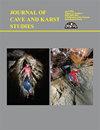新墨西哥州阿尔伯克基盆地西北部Santa Fe组含水层调查
IF 0.5
4区 地球科学
Q4 GEOSCIENCES, MULTIDISCIPLINARY
引用次数: 0
摘要
为了更好地了解和管理地下水,Rio Rancho市资助了一项研究:1)绘制Santa Fe Group含水层的3D分布图,包括Albuquerque盆地西北部的内部水文地层单元;2)评估含水层中水文地层单元内部和之间的渗透率差异。辅助目标是评估TDS和放射性碳年龄的空间趋势。根据地层的结构和组成,识别出具有独特水文地质性质的4个地层单元:上里奥兰乔(URR)、中里奥兰乔(MRR)、下里奥兰乔(LRR)和齐亚(Zia)水文地层单元。分隔这些单元的接触暴露在里奥兰乔北部和西部的陆地表面上。通过ArcMAP绘制构造等高线,在井下数据(利用地球物理测井和存档的岩屑)的指导下,将这些接触面投影到地下。主要断层的倾斜断层面(垂直偏移量>100 m)也绘制了数字构造等高线。网格栅格文件是用ArcGIS工具“Topo to raster”创建的,输入是结构轮廓和井中被选中的接触点的高程。通过减去给定HSU的顶部和底部来绘制每个HSU的等距图。在ArcScene中使用网格栅格表面和断层结构轮廓绘制三维模型的可视化。我们还创建了2D图像,以直观的格式显示模型的地质特征。为了进一步帮助可视化Santa Fe Group含水层,我们使用两个正交截面和Google earth衍生的陆地表面制作了一个3D块体模型。所有四个hsu都在东南方向变厚,在齐亚和科罗纳多断裂带之间向北略厚。URR和MRR HSUs在北向的齐亚纳宿主上空稀薄。将液压泵测试数据与HSU(基于给定井的筛选深度)相关联表明,与MRR相比,URR和LRR可能具有更高的渗透率(2-3倍)。然而,MRR的范围和相对较大的饱和厚度意味着它在为城市提供地下水方面发挥着重要作用。现有的泵送测试数据表明,研究区西南部MRR区的水力导电性略高,这可能是由于Cerro Conejo组Benevidez段的砂质层载比例较高,但需要更多的井数据来证实这种明显的横向趋势。地下水中最年轻的碳-14值是在东部,格兰德河附近的URR中发现的。最高的TDS值出现在靠近Ziana宿主的LRR HSU中,这与gloria Geoscience公司早期的水文地质研究结果一致。济阿那地块的断裂带可能是将劣质水从断裂基岩中排出的管道,而构造高度较高、相对渗透性较强的LRR可能是将劣质水向南输送到研究区的通道。本文章由计算机程序翻译,如有差异,请以英文原文为准。
Santa Fe Group Aquifer Investigations in the Northwestern Albuquerque Basin, New Mexico
In order to better understand and manage their groundwater, the City of Rio Rancho funded a study to: 1) map the 3D distribution of the Santa Fe Group aquifer, including internal hydrostratigraphic units, in the northwestern Albuquerque Basin, and 2) assess permeability differences within and between hydrostratigraphic units in the aquifer. An ancillary goal was to assess spatial trends of TDS and radiocarbon ages. Four stratigraphic units were recognized based on their texture and composition which were inferred to possess unique hydrogeologic properties: the Upper Rio Rancho (URR), Middle Rio Rancho (MRR), Lower Rio Rancho (LRR), and Zia hydrostratigraphic units (HSUs). Contacts separating these units are exposed on the land surface north and west of Rio Rancho. These contacts were projected into the subsurface, guided by subsurface picks in well data (made using geophysical logs and archived cuttings), via drawing of structural contours in ArcMAP. Structural contours were also digitally drawn for dipping fault planes of major faults (with >100 m vertical offset). Gridded raster files were created with the ArcGIS tool called Topo to Raster, where the inputs were the structural contours and the elevations of the picked contacts in wells. Isopach maps for each HSU were made by subtracting the top and base of a given HSU. A visualization of the 3D model was rendered in ArcScene using the gridded raster surfaces and fault structural contours. We also created 2D images that display geologic features of the model in an intuitive format. To further aid visualization of the Santa Fe Group aquifer, we made a 3D block model using two orthogonal cross sections and a Google Earth-derived land surface. All four HSUs thicken to the southeast, and are slightly thicker northward between the Zia and Coronado fault zones. The URR and MRR HSUs thin over a north-trending Ziana horst. Correlating hydraulic pump-test data with HSU (based on screened depths of a given well) indicate that the URR and possibly LRR have higher permeabilities (by a factor of 2-3) compared to the MRR. However, the extent and relatively large saturated thickness of the MRR means it plays an important role in providing groundwater for the City. Available pumping test data suggest that hydraulic conductivities in the MRR are slightly higher in the southwest part of the study area, perhaps due to the proportionally high sand bedload of the Benevidez Member of the Cerro Conejo Formation, but more well data are needed to confirm this apparent lateral trend. The youngest C-14 values in the groundwater are found to the east, near the Rio Grande, in the URR. The highest TDS values are found in the LRR HSU on or immediately adjacent to the Ziana horst, consistent with earlier hydrogeologic studies by Glorieta Geoscience Inc. Fault zones bounding the Ziana horst may be conduits for expelling poor-quality water from fractured bedrock at depth, and the structurally high, relatively permeable LRR may act as a pathway in transmitting this lower-quality water southwards into the study area.
求助全文
通过发布文献求助,成功后即可免费获取论文全文。
去求助
来源期刊

Journal of Cave and Karst Studies
地学-地球科学综合
CiteScore
1.90
自引率
0.00%
发文量
6
审稿时长
>12 weeks
期刊介绍:
The Journal of Cave and Karst Studies is a multidisciplinary journal devoted to cave and karst research. The Journal is seeking original, unpublished manuscripts concerning the scientific study of caves or other karst features. Authors do not need to be members of the National Speleological Society, but preference is given to manuscripts of importance to North American speleology.
 求助内容:
求助内容: 应助结果提醒方式:
应助结果提醒方式:


